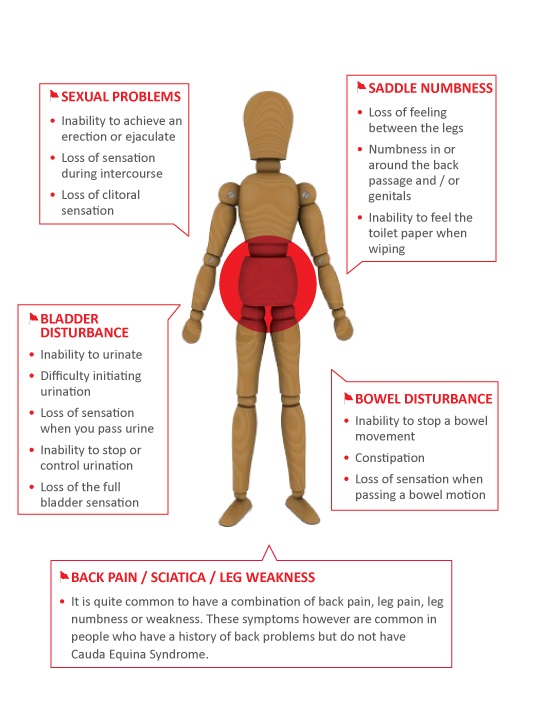Why Cauda Equina ?
Cauda Equina comes from Latin and means ‘Horse’s tail.’ It is the name given to the collection of nerves roots that emerge from the spinal cord where it ends at the Conus Medullaris ( L2) . It continues at this point as long nerves that resemble a horse’s tail – hence the name.

How do you get Cauda Equina syndrome?
Cauda Equina syndrome is a set of symptoms that are experienced when the spinal nerves are compressed in lower the back. It occurs at spinal vertebral levels below L3 where the Conus Medullaris ends and the Cauda Equina nerves emerge at the base of the spinal cord.
Compression of these nerves inhibits function and generates painful messages as well as symptoms. These are known as the ‘Red Flags of CES’ . They include acute low back pain, sciatica, bladder and bowel dysfunction, leg weakness and sexual dysfunction.
The compression can be caused by a slipped disc, tumours, stenosis, cysts and occasionally injections. Cauda Equina syndrome can also be a result of a car accident.
These symptoms form the syndrome but can lead to permanent disability ( usually preventable when treated emergently). People living with these permanent injuries consider themselves to be ‘People living with Cauda Equina syndrome’.
What are the different stages of Cauda Equina syndrome?
CES-S
This means Cauda Equina Syndrome – Suspected. It is a diagnosis given to patients who present with lower back pain and bilateral leg pain but who have no autonomic issues like bladder, bowel, sexual dysfunction. It is also known as impending? CES
CESI
This means Cauda Equina Syndrome – Incomplete. It is a diagnosis given to patients who may be experiencing loss of sensation and leg weakness in the lower limbs.
Differing levels of lumbar back pain and leg pain.
Bladder issues such as loss of desire to void, altered urinary sensation, hesitancy and poor stream.
Partial saddle anaesthesia. It is experienced as numbness/pins and needles around the genitals and bottom (where you would sit in a saddle). An inability to feel toilet paper when wiping is a good indication of saddle anaesthesia.
Anal sphincter tone is reduced.
CESR
This means Cauda Equina Syndrome with Retention. It is a diagnosis given to patients whose condition has deteriorated to a point where bladder function ceases and the bladder goes into retention. This is painless and overflow incontinence will occur.
Saddle anaesthesia has progressed to total sensory loss and pins and needles become dense numbness.
Patients may suffer from faecal incontinence.
Image courtesy of Nish Srikandarajah.
The different stages of CES occur over time and onset of CES can be either acute of slow. It can develop over a few hours, or weeks and months.

Recovery from Cauda Equina Syndrome
Patients will have the best chance of a full recovery if they receive the correct treatment (usually a spinal decompression within 24 hours) at stage CES-S or CESI, before urinary retention occurs and as a result, the hope of returning to a normal lifestyle.
When a patient has progressed to CESR then the prognosis is not as good. Many are left to come to terms
with permanent life changing disabilities and to cope with chronic, neuropathic pain and fatigue.
Research
Below is a research article by Nisaharan Srikandarajah’s who is a member of our medical panel with a keen interest in CES.
Cauda Equina Syndrome Core Outcome Set (CESCOS): An international patient and healthcare professional consensus for research studies
If you are located in the UK and live with CES we would appreciate it if you could join our Patient Participation Facebook group and participate in our surveys and questionnaires to enable us to measure outcomes of living with ces.
